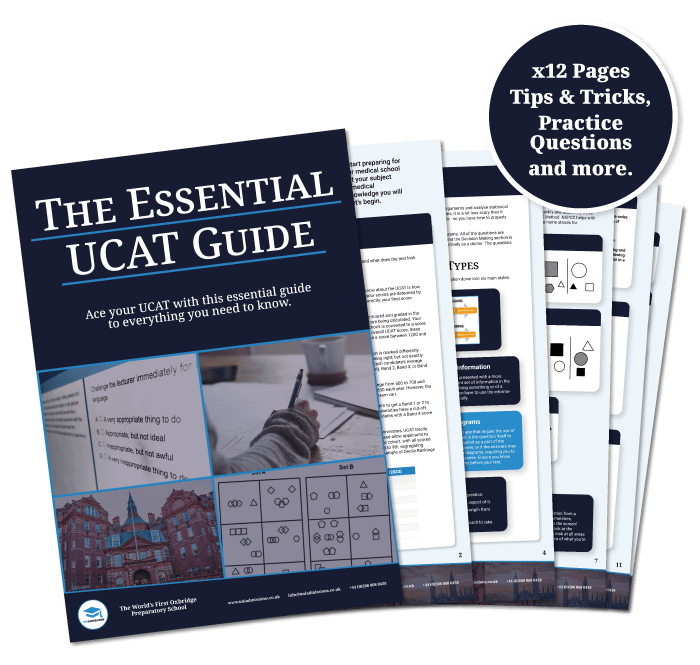What are the different UCAT sections and subtests? What do they test and what should I expect?
The UCAT is more than just a medical Admissions Test. It has 4 different subtests used to help Admissions Tutors identify if you are a suitable candidate for studying Medicine or Dentistry at their Medical School.
So what are the different subtests and what will come up? We outline and share insights into each UCAT subtest below.
UCAT Removes Abstract Reasoning For 2025
It was announced in December 2024 that the Abstract Reasoning subtest of the UCAT will be removed for the 2025 sitting. This means applicants will now only need to complete 4 subtests. Timings and question totals have been updated to account for this.
This marks the latest in a series of significant changes to the medicine admissions process, following the removal of the Biomedical Admissions Test (BMAT), previously used by several UK medical schools. These schools have now transitioned to the UCAT, making it the sole admissions test for undergraduate medicine and dentistry in the UK.
In 2025, the Personal Statement writing process will also be seeing a major overhaul which will affect medicine and dentistry applicants in the UK.
Learn more about these changes to the UCAT in our UCAT Changes 2025 Guide here. Please bear with us while we update all information on our guide to the new format for the UCAT
How is the UCAT timed?
The UCAT or “University Clinical Aptitude Test” is sat by most students applying to study Medicine or Dentistry in the UK. It is more of an aptitude test than an academic test and it tests abilities such as Problem Solving and Critical Thinking.
As shown in the table below, the UCAT is made up of 4 sections: Verbal Reasoning, Decision Making, Quantitative Reasoning and Situational Judgement. Each has a set time based on the estimated length of time to answer the questions.

Maximise your UCAT score through effective UCAT preparation.
The UCAT exam is a vital component of your Medicine application so scoring highly can mean the difference between an offer or rejection. At UniAdmissions, we are experts at boosting your UCAT score and maximising your chances of gaining a place to study Medicine.
Discover our UCAT Programme by clicking the button below to enrol and triple your chances of success.
What are the UCAT sections?
1. Verbal Reasoning
All things considered, you have roughly thirty seconds to answer each question, but you can’t answer anything until you’ve read a ~750 words long passage of text.
The questions themselves aren’t linguistically difficult, but they may require you to understand the transitive properties of elements in the text e.g. the first paragraph may talk about A and how it relates to B, the second paragraph relates B to C, so what about A is to do with C?
This section is probably the one where timing is the most brutal, and the limiting factor is the time taken to properly read the passage.
Don’t expect the answer to every question to be available as a direct quote from the text – some interpretation is necessary. Questions may ask about specific details that you may not have properly acknowledged, so refer back to the text when figures are involved.
With that in mind, the best advice is to learn to speed read. Practice as much as you can on reading as quickly as possible whilst still understanding the text. Also, make sure you practice reading on a computer, it’s not the same as reading on paper.
2. Decision Making
Decision Making was introduced in 2017, replacing an older section called Decision Analysis. This section lasts 37 minutes, and there are 35 questions; this means roughly one question a minute. You will be presented with questions that refer to text, charts, tables, graphs or diagrams.
As a general principle, drawing diagrams is extremely helpful in this section. It helps you visualise data that is written in text. For example, if a question speaks about compass directions, draw a simple map that follows the rules. If the question is talking about categories, then draw a Venn diagram that simplifies your thought process.
The questions are designed to assess how you use information and data to, unsurprisingly, make a decision – an essential skill of a good doctor. The questions can be broken down into six main styles:
- Logical puzzles
- Syllogisms
- Interpreting information
- Recognising assumptions
- Venn diagrams
- Probabilistic reasoning
Claim Your FREE Essential UCAT Handbook
The UCAT is a requirement for most medical schools in the UK, so it’s important that you are well-prepared so you can score highly and earn your interview invitations. With our Essential UCAT Guide, you will find a detailed breakdown of each section, preparation tips, practice questions and more. Fill out the form below to gain free access right away!

3. Quantitative Reasoning
The maths itself is not any more difficult than GCSE level, but questions may require several calculations to be made in quick succession. There is also a lot of interpretive analysis, so make sure you’re comfortable with pie charts, bar charts and the like. Currency and unit conversions are also common.
With these questions, it’s essential that you keep track of units! The exam is multiple-choice, and possible answers will often have similar values with different units – don’t be put off, learn to keep track.
If, like me, your mental arithmetic is terrible, fear not for you have access to a rudimentary calculator. Unfortunately, it isn’t a physical one, but rather a desktop application. It only has basic functionality.
My best advice for this section is to practice calculations on this calculator. Find an extended keyboard (one with a separate number pad) and get comfortable using it. The faster you get with this, the more precious seconds you’ll be able to spend without fiddling with a mouse or keys.
4. Situational Judgement
Situational Judgement, or SJT, tests the qualities required to work in healthcare. This might be ethics, your ability to work in a team or integrity. It is a psychological aptitude test.
This section consists of 20 scenarios with 69 items; each scenario has 3-6 items. You have 26 minutes to complete this section, which translates to around 22 seconds per item. This is the last section, so you may begin to fatigue. Make sure you stay focused and be careful to mark the intended answers!
There are two sets of answers for items in the SJT:
- Appropriateness – this will be from “very appropriate” to “very inappropriate” with two choices in between.
- Importance – this ranges from “very important” to “not important at all”.
This section benefits from practice as you will begin to understand the types of questions and answers that frequently appear. Read through the Good Medical Practice too as this will help with your selection process.
If there are several people mentioned in the scenario, make sure your answer relates to the correct person. You must think about what you should do rather than what you would actually do. A general rule of thumb to follow for this section is to always put patient safety first, acting in the patient’s best interest.
Searching for UCAT support to strengthen your Medicine application?
The UCAT is a vital component of your medicine application so scoring highly can mean the difference between receiving your dream offer or rejection.
Our Medicine Premium Programme gives you complete application support to triple your chances of success.








